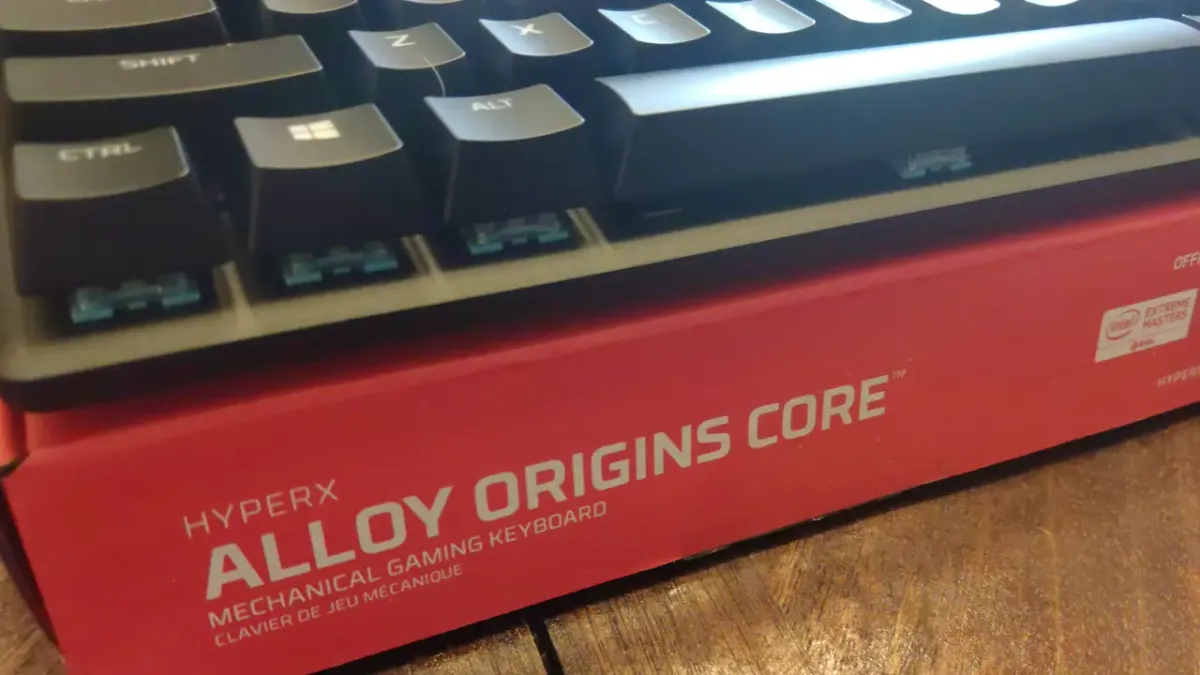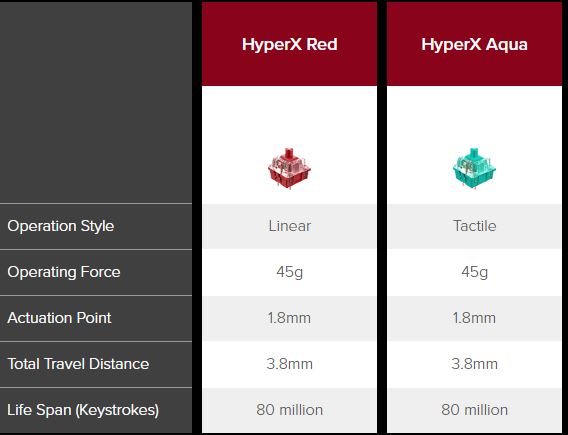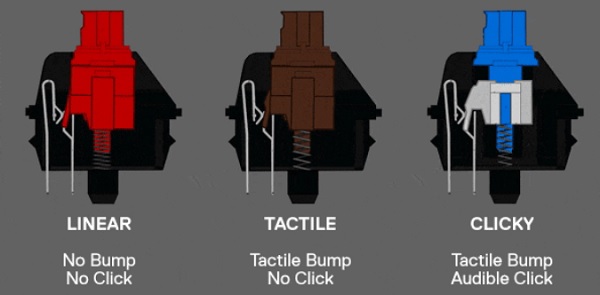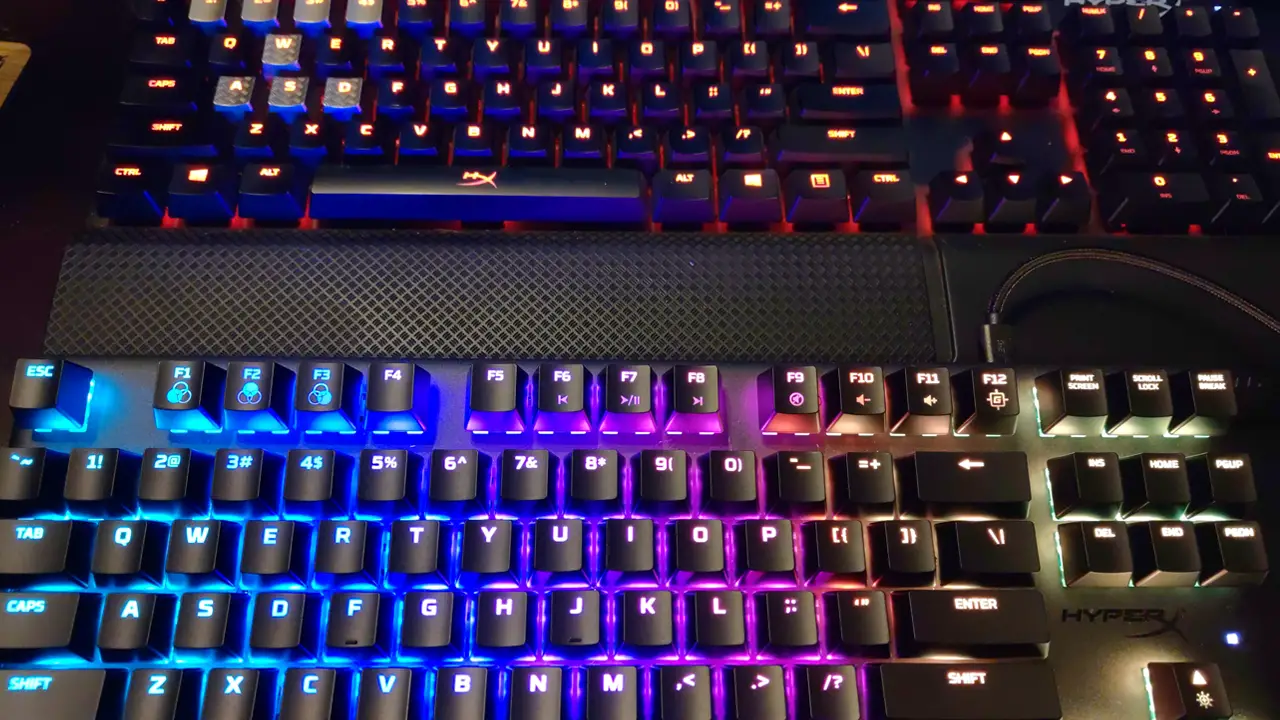
If you’ve read my keyboard reviews in the past, you know I have an affinity for Cherry MX red key switches. In my opinion (and that of many others along with me), they are the top of the shelf for first person shooters, and they hold up better than any others, with a useful life of over 80 million key presses. One of the reasons they are so favored is that they are a linear switch, meaning they don’t have a mid-throw bump to activate. This means repeating a press can happen at any depth, allowing a double-tap of a key faster than any other type. Best of all, they do this without the “clack” of a normal keyboard. You can imagine my surprise when HyperX decided to try to beat them at their own game.
Over the last few weeks of isolation thanks to the COVID-19 virus, I’ve had far more keyboard time than any other period. As a result, I’ve had a ton of uninterrupted keyboard use, whether it be for work or gaming. This has given me the opportunity to put the Alloy Origins Core up against the HyperX Alloy FPS Pro and the HyperX Alloy Elite keyboards, both sporting the aforementioned Cherry MX Red keys. This newest board from HyperX uses a new key called “HyperX Aqua”. Before we get to hammering on the keys, let’s look at them head to head.
As you can see, HyperX didn’t want an “almost good-as” key, they wanted to replicate the Cherry MX Red’s capabilities and features perfectly. I was interested to see if I could detect any real differences between them.
Much like its predecessors, the Alloy Origins Core sports a full aircraft-grade aluminum body. This gives the keyboard enough heft to prevent it from moving around, keeping the device stationary even in the most DOOM Eternal level firefights.
The Alloy Origins Core sports full N-key rollover technology. N-key rollover, more colloquially (but incorrectly) known as “Ghosting” is when you press multiple keys simultaneously and the keyboard fails to register or confuses the input – something Microsoft has explained in great detail right here, even including a testing utility to give your new keyboard a run for its money. Ghosting on the other hand is where you press two keys, and somehow a key you didn’t press is also activated, due to shared “community of keys” wiring in a cheap board. Here, every key is individually addressed with their own wiring, providing full prevention of accidental key cross-contamination of commands.
Removing the keys (every key can be removed, allowing you to use things like these keycaps) reveals the aqua colored switch carefully sealed in a clear body. This allows the full RGB lighting to shine through. These new Aqua switches are tactile, and the Cherry MX Red are linear, with the former having the aforementioned “bump” feeling. Unlike the Red keyboard switches, you can feel the switch return to a “reset” position halfway back up through the key throw. Rather than try to explain it further, why not a simple demonstration?
Most people who type on keyboards regularly prefer the tactile key type. As repeated key presses aren’t that frequent when typing, the “feel” helps the person touch-typing to maintain a consistent typing speed. Essentially you can both subtly feel and hear the actuation when you’ve successfully struck a key. The question for me was, how would it fare when the bullets started flying?
DOOM Eternal, especially on the highest difficulty levels, will tax your skills. Any delays on the keyboard can translate to getting your Doomguy chewed up and spit out by angry demons. The shorter throw (0.2mm shorter than the average keyboard) on the keyboard didn’t seem to make a real difference. That isn’t to say that it’s a bad thing, but the extra 0.2 nanometer reduction in throw distance is so slight that it compensated for the secondary action of being a tactile keyboard (instead of linear), but little else. It performs just like a Cherry Red switch mechanical board.
Speaking of colors, naturally the Alloy Origins Core supports a full array of RGB colors. You can use the downloadable NGenuity software to get very specific with your lighting layouts, or you can use the function toggles to go from on, off, a pulsing and fading setting, a “trigger” setting where the keys light up as you press them, and an “explosion” setting where each key press kicks off a firework-like explosion of light from the last key you pressed. It’s entirely cosmetic, but it’s also one of the best examples of making LEDs more interesting I’ve seen on a keyboard.
The Alloy Origins Core is compatible with PC, Xbox One, and PlayStation 4, and it’s very clear that HyperX wanted to keep the keyboard compact. As a result, they’ve put it on a diet, removing the full ten-key sidecar, macro keys, and media controls, while still retaining the full sized keys you’d expect. The device connects to your PC with an included detachable braided and reinforced USB cable — no need to wrap it around the board like an old cheap board from the past. Underneath the board lies another surprise.
Most keyboards have a pair of feet that allows them to sit at an angle or to remain flat. On the Alloy Origins Core there are two stages of feet with three angle adjustments instead of just two. Sitting flat, the board sits at three degrees, with the first foot placement being seven, and the tallest being eleven degrees. This allows the board to be used from a wider variety of angles, which is great for hand and wrist fatigue — I hope this becomes the norm moving forward.
There is one thing that I wish hadn’t been trimmed from the board when it was slimmed down — the rear USB pass-through port. Instead, you’ll have to occupy two USB ports on your system for the mouse and keyboard. Given that this board is easily aimed at being a small and portable board for LAN gaming and the like, it seems like a bit of an oversight.
HyperX Alloy Origins Core
Excellent
HyperX has managed to upset 35 years of Cherry MX keyboard domination with a beautiful switch type of their own. With the same smooth action, albeit with the tactile bump, this newest switch delivers on its promises. I do wish that it had a USB pass-through, but everything else seems to line up as a step forward for this line of hardware.
Pros
- Full aircraft-grade aluminum body
- Three angle adjustments instead of two
- Detachable USB-C braided cable
- Feels like a Cherry Red switch mechanical board
- Compact and extremely sturdy construction
Cons
- No USB passthrough port
- Shorter throw doesn’t seem to add much



